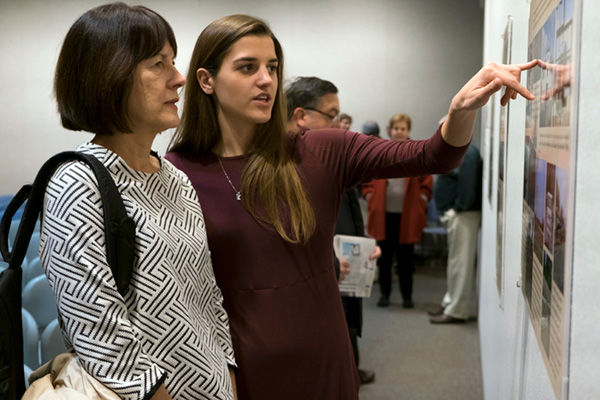Holocaust beyond the numbers
Published February 8, 2017
With four grandparents who survived the horrors of Nazi Germany, Rachel Berger is no stranger to the stories from the Holocaust.
And when she came to Washington University from New York City, she was one of 13 students who took an intensive freshman class on the topic, studying first the factual history of the World War II genocide, then books and films depicting it.
But when she and her classmates took a 12-day trip to Germany, Poland and Lithuania in May, they realized their learning had just begun.
“We all spent a year studying the Holocaust, and there’s still so much that we don’t know,” she said last week at a reception and panel discussion opening a class exhibit at the Holocaust Museum and Learning Center.
Filling that void was one big goal of the course created by Erin McGlothlin, an associate professor of Germanic languages and Jewish, Islamic and Near Eastern languages and cultures, and Anika Walke, an assistant professor of history. Their deep dive into the Holocaust is part of Washington U.’s FOCUS program, in which freshmen immerse themselves in one topic for an academic year.
The professors said the course was designed not only to study events from World War II but to see how they reverberate today.
Valke said: “The idea is to show them how current European societies are dealing with the memory of concentration camps and how you can learn about the genocide that in many cases did not leave a lot of traces.”
To help prepare for the trip, McGlothlin said, students read books about the Holocaust, both fictional accounts and actual testimony, and watched films such as “Shoah” and “Schindler’s List.”
“I wanted them to understand all of the very, very complex factors that went into the Holocaust, not only to the experience itself but to people’s reactions to it and how they wrote about it many years later,” she said.
The students’ trip started in Germany. As they traveled eastward from Berlin, they noticed that at first, there were Holocaust memorials “practically on every corner,” said Cecily Hibbs, one of three students who helped put together the exhibit.
But when they moved on to Poland and Lithuania, the memorials decreased, so that in some places they could hardly tell that a death camp had been nearby.
Visiting the sites where the atrocities that they had been studying actually took place left a profound impression on the students.
“We knew the numbers, but actually seeing it was a very impactful experience,” Talia Wazana said.
Abigail Wippel said, “You can sit in a classroom all day long, but when you’re standing there and you see where all of that stuff was going on, it really becomes personal.
“I couldn’t fathom how it happened and wanted to try to understand. I came away realizing that you can’t really explain why it happened.”
In a video (http://bit.ly/WashU-class2017) and the panel discussion at the opening of the exhibit, students talked about moments on the trip that affected them most: seeing human hair that had been shorn from the victims, cups that had been taken away, gas canisters used to kill Jews and others.
“Without this, my worldview would be different,” Gina Vellequette said. “It has literally changed my life.”
The trip was also a bonding experience for the students. McGlothlin said they still send group text messages almost daily, and “when they see me, they say, ‘Hi, Mom.’ ”
The experience also brought a deepening awareness of how conditions that gave rise to Nazi Germany can have disturbing echoes today. Berger said she knows the situations are different, and she hopes Americans will be more welcoming to foreigners than the Nazis were, “but it’s still extremely scary.”
Vellequette said: “People need to be more accepting. We had the opportunity to save people, and we didn’t. Now we have that again.”
McGlothlin said such realizations are part of what the course is about.
“Sometimes students choose to study the Holocaust because they want an emotional experience,” she said. “I wanted them to go beyond their emotional reactions to think about what does it mean to document this experience. What are we learning?
“Students are careful not to make uninformed comparisons, but they are extremely interested in learning about the factors of how it happened, where there were differences and where they weren’t, and how Germany transformed in such a short period from democracy to totalitarian state.”
Based on the students’ reactions, McGlothlin thinks the lessons took hold.
“Sometimes, we have a really critical attitude of what this generation does and doesn’t do, whether they have an attitude that all they care about is getting a job and making money,” she said.
“I wanted to show how students honestly engage with something that really is quite overwhelming to them, and they were very valiant in tackling this subject. It gives you hope for the future in seeing students engaging in such an earnest way.”
Berger said it showed her how individuals can truly make a difference.
“You can’t say I’m just one person, and I can’t do anything,” she said. “You always can do something about it.”
















